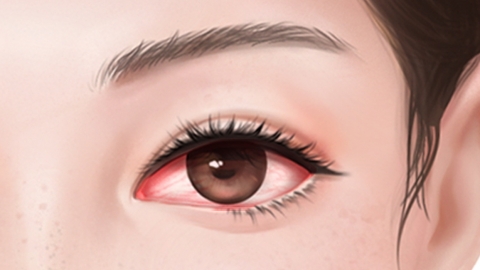Why do my eyes feel blurry, as if covered by a fog?
Generally, blurred vision that feels like a fog covering the eyes may be caused by excessive eye use, lack of sleep, dry eye syndrome, conjunctivitis, glaucoma, or other reasons. It is recommended to seek timely medical attention and receive treatment under a doctor's guidance. A detailed explanation is as follows:

1. Excessive Eye Use
Prolonged close-range eye use, such as continuous use of electronic devices or reading, keeps the ciliary muscles of the eyes in a tense and contracted state. The lens becomes more convex to adjust focus and see nearby objects clearly. Long-term strain can fatigue the ciliary muscles, impairing their ability to regulate the lens normally, which leads to a decline in focusing ability and blurred vision, as though covered by a fog. It is recommended to change eye-use habits, take regular breaks, and avoid prolonged continuous eye strain.
2. Lack of Sleep
During sleep, the eye's tissues and functions undergo self-repair and adjustment. When sleep is insufficient, the eyes do not get adequate rest, causing dilation of ocular blood vessels, poor blood circulation, and accumulation of metabolic waste within the eye. This affects the normal function of the retina and other ocular tissues, resulting in blurred vision. Maintaining a regular daily routine and ensuring 7-8 hours of high-quality sleep per day is recommended. Avoid using electronic devices before bedtime, as they can impair sleep quality.
3. Dry Eye Syndrome
Dry eye syndrome is typically caused by insufficient tear production, rapid tear evaporation, or abnormal tear composition. When tear function is compromised, the stability of the tear film on the ocular surface decreases and it can no longer evenly coat the surface of the eyeball, thereby interfering with light refraction and causing blurred vision. Symptoms may also include dryness, foreign body sensation, and burning in the eyes. Patients can use medications such as sodium hyaluronate eye drops, polyvinyl alcohol eye drops, or carboxymethylcellulose sodium eye drops under a doctor's guidance.
4. Conjunctivitis
Conjunctivitis is often caused by microbial infection, allergic reactions, or physical or chemical irritation. Inflammatory stimulation leads to conjunctival congestion, swelling, and increased secretions. These secretions may adhere to the corneal surface, affecting light transmission. The inflammation may also involve the cornea, causing minor damage and resulting in blurred vision. Symptoms may also include red eyes, foreign body sensation, and increased secretions. Patients should follow medical advice to use medications such as levofloxacin eye drops, tobramycin eye drops, or ofloxacin eye ointment to alleviate symptoms.
5. Glaucoma
Glaucoma mainly results from elevated intraocular pressure that damages the optic nerve. Obstructed circulation of aqueous humor, excessive aqueous production, or impaired drainage can cause increased intraocular pressure. This elevated pressure compresses the optic nerve fibers, affecting nerve conduction and damaging retinal ganglion cells, which impairs visual function and causes blurred vision. Accompanying symptoms may include eye pressure, eye pain, and headache. Patients can use medications such as timolol maleate eye drops, betaxolol hydrochloride, or latanoprost eye drops as advised by a doctor.
In daily life, it is important to use eyes reasonably and avoid using them under excessively bright or dim lighting. Maintain a balanced diet and consume more foods rich in vitamins A, C, and E, as well as lutein, such as carrots, oranges, and blueberries.







